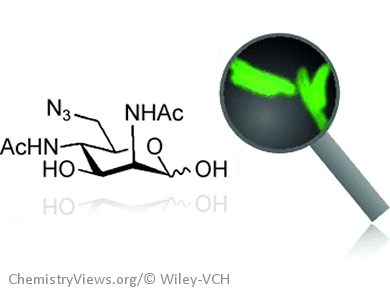Tracking the Cause of Legionnaires’ Disease
The bacterium that causes Legionnaires’ disease remains difficult to track. French researchers have now developed a new technique that should allow living representatives of this dangerous pathogen to be detected much more quickly than with conventional methods. As they report in the journal Angewandte Chemie, samples are exposed to an azide-modified compound that the pathogen specifically incorporates into its shell, which is made of saccharide units. A fluorescent marker attached to the azide groups is used to identify the pathogen.
In the summer of 1976, a previously unknown disease broke out at a convention of the American Legion in Philadelphia. Of the 221 people infected, 34 died. The disease now known as Legionnaires’ disease has broken out many times since then. The pathogen behind it was identified as a bacterium called Legionella pneumophila that proliferates in systems of standing water at temperatures between 25 and 50 °C, such as water reservoirs, boilers, fountains, whirlpool tubs, or intermittently used water pipes. Although drinking the contaminated water poses no risk, inhaling droplets leads to severe lung infections.
Faster Detection
In order to avoid epidemics, it is necessary to monitor vulnerable systems. However, traditional testing methods based on bacterial cultures require 10 days to identify the pathogen – far too late to intervene in suspected cases. Sam Dukan, Boris Vauzeilles, and their team at the Institute for the Chemistry of Natural Substances (CNRS, Gif-sur-Yvette), the Institut de Chimie Moléculaire et des Matériaux d’Orsay, CNRS/Université Paris-Sud and the Institut de Microbiologie de la Méditérranée, CNRS/Aix-Marseille University, both France, have now developed a new method that can be used to identify living bacteria of the species Legionella pneumophila within just one day.
Legionella are Gram-negative bacteria with a species-specific pattern of saccharide molecules on their surface, called the lipopolysaccharides. In Legionella pneumophila, these contain a special saccharide building block that other bacteria do not have. For their new test, the researchers exposed the sample to a precursor molecule of this saccharide with an additional azide group (–N3) tacked on. If the bacteria in question are present, they take up this substance and use it to build the saccharide building block to use in their lipopolysaccharides—which are now tagged with azide groups. These groups can then be used to attach various probes to the surface of the cell. For example with a fluorescent label, the marked bacteria give off a green glow under a microscope. Because only Legionella pneumophila synthesizes the special saccharide building blocks, other species of Legionella are not marked in this process. This new method is the first successful metabolic lipopolysaccharide label using a specific saccharide that can selectively detect one species.
- Identification of Living Legionella pneumophila Using Species-Specific Metabolic Lipopolysaccharide Labeling,
Jordi Mas Pons, Audrey Dumont, Grégory Sautejeau, Emilie Fugier, Aurélie Baron, Sam Dukan, Boris Vauzeilles,
Angew. Chem. Int. Ed. 2014,
DOI: 10.1002/anie.201309072




